Greenhouse gases hit record high in 2022: UN
Robin MILLARD
Wed, November 15, 2023
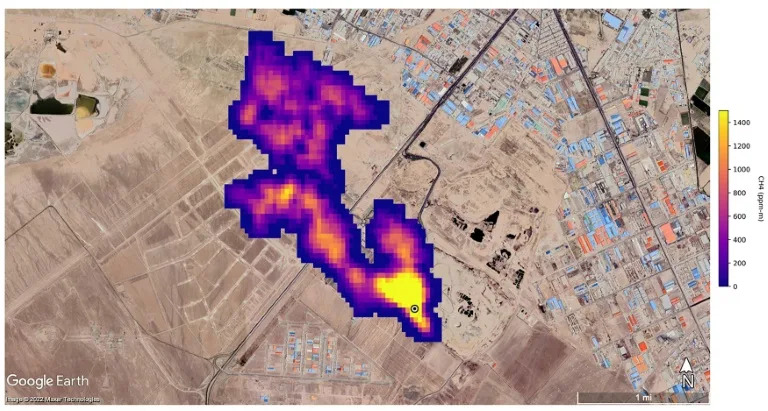
Methane plumes several kilometres (miles) long are now being detected by the NASA space agency as greenhouse gas concentrations hit a new record high (-)
Greenhouse gas concentrations in the atmosphere hit new record highs in 2022, with no end in sight to the rising trend, the United Nations warned Wednesday.
The UN's World Meteorological Organization said levels of the three main greenhouse gases -- the climate-warming carbon dioxide, methane and nitrous oxide -- all broke records last year.
Such levels of heat-trapping gases will mean further temperature increases, more extreme weather and higher sea levels, the WMO said in its 19th annual Greenhouse Gas Bulletin.
"Despite decades of warnings from the scientific community, thousands of pages of reports and dozens of climate conferences, we are still heading in the wrong direction," said WMO chief Petteri Taalas.
The bulletin comes ahead of the November 30-December 12 COP28 UN climate summit in Dubai.
The 2015 Paris Agreement saw countries agree to cap global warming at "well below" two degrees Celsius above average levels measured between 1850 and 1900 -- and 1.5C if possible.
The global mean temperature in 2022 was 1.15C above the 1850-1900 average -- and Taalas said it was all but certain that 2023 would be the warmest year on record.
"The current level of greenhouse gas concentrations puts us on the pathway of an increase in temperatures well above the Paris Agreement targets by the end of this century," said Taalas.
"This will be accompanied by more extreme weather, including intense heat and rainfall, ice melt, sea level rise and ocean heat and acidification.
"The socioeconomic and environmental costs will soar. We must reduce the consumption of fossil fuels as a matter of urgency."
- 'No magic wand' -
In 2022, carbon dioxide concentrations were at 418 parts per million, methane at 1,923 parts per billion and nitrous oxide at 336 parts per billion.
These values constitute, respectively, 150 percent, 264 percent and 124 percent of the pre-industrial (before 1750) levels.
Of the three major greenhouses gases, carbon dioxide (CO2) accounts for about 64 percent of the warming effect on the climate.
Global averaged concentrations of CO2 in 2022 were, for the first time, 50 percent above those of the pre-industrial era, and "continued to grow in 2023", said the WMO.
"Given the long life of CO2, the temperature level already observed will persist for several decades even if emissions are rapidly reduced to net zero," the WMO warned, with Taalas adding: "There is no magic wand to remove the excess carbon dioxide from the atmosphere".
Atmospheric methane is the second largest contributor to climate change, accounting for around 16 percent of the warming effect.
Methane remains in the atmosphere for only about 10 years, but has a much more powerful warming impact than CO2.
"We don't fully understand why methane concentrations are steadily growing," said Taalas.
For nitrous oxide -- accounting for around seven percent of the warming effect -- the increase last year "was higher than that observed any time before in our modern time record", the WMO said.
Around 80 percent of greenhouse gas emissions come from G20 countries.
- Tipping points -
Although the scientific community has a broad understanding of climate change and its implications, there are still some uncertainties about the carbon cycle -- and the fluxes in the ocean, the land biosphere and the permafrost areas.
The bulletin called for greater information on certain topics.
These included feedback loops in the climate system -- for example, increased carbon emissions from soils or decreased carbon uptake by oceans due to climate change.
The WMO is also concerned about so-called tipping points, where a certain level of change leads to a self-accelerating and potentially irreversible cascade of changes.
One could be how parts of the Amazon rainforest, long a carbon sink, has now become a source of carbon emissions due to deforestation.
The organisation said more information is also needed on non-CO2 greenhouse gases.
Taalas said there was a risk that the wars in Ukraine and Gaza were overshadowing climate change, which "is still the biggest challenge for the welfare of mankind this century".
rjm/giv
Wed, November 15, 2023

Methane plumes several kilometres (miles) long are now being detected by the NASA space agency as greenhouse gas concentrations hit a new record high (-)
Greenhouse gas concentrations in the atmosphere hit new record highs in 2022, with no end in sight to the rising trend, the United Nations warned Wednesday.
The UN's World Meteorological Organization said levels of the three main greenhouse gases -- the climate-warming carbon dioxide, methane and nitrous oxide -- all broke records last year.
Such levels of heat-trapping gases will mean further temperature increases, more extreme weather and higher sea levels, the WMO said in its 19th annual Greenhouse Gas Bulletin.
"Despite decades of warnings from the scientific community, thousands of pages of reports and dozens of climate conferences, we are still heading in the wrong direction," said WMO chief Petteri Taalas.
The bulletin comes ahead of the November 30-December 12 COP28 UN climate summit in Dubai.
The 2015 Paris Agreement saw countries agree to cap global warming at "well below" two degrees Celsius above average levels measured between 1850 and 1900 -- and 1.5C if possible.
The global mean temperature in 2022 was 1.15C above the 1850-1900 average -- and Taalas said it was all but certain that 2023 would be the warmest year on record.
"The current level of greenhouse gas concentrations puts us on the pathway of an increase in temperatures well above the Paris Agreement targets by the end of this century," said Taalas.
"This will be accompanied by more extreme weather, including intense heat and rainfall, ice melt, sea level rise and ocean heat and acidification.
"The socioeconomic and environmental costs will soar. We must reduce the consumption of fossil fuels as a matter of urgency."
- 'No magic wand' -
In 2022, carbon dioxide concentrations were at 418 parts per million, methane at 1,923 parts per billion and nitrous oxide at 336 parts per billion.
These values constitute, respectively, 150 percent, 264 percent and 124 percent of the pre-industrial (before 1750) levels.
Of the three major greenhouses gases, carbon dioxide (CO2) accounts for about 64 percent of the warming effect on the climate.
Global averaged concentrations of CO2 in 2022 were, for the first time, 50 percent above those of the pre-industrial era, and "continued to grow in 2023", said the WMO.
"Given the long life of CO2, the temperature level already observed will persist for several decades even if emissions are rapidly reduced to net zero," the WMO warned, with Taalas adding: "There is no magic wand to remove the excess carbon dioxide from the atmosphere".
Atmospheric methane is the second largest contributor to climate change, accounting for around 16 percent of the warming effect.
Methane remains in the atmosphere for only about 10 years, but has a much more powerful warming impact than CO2.
"We don't fully understand why methane concentrations are steadily growing," said Taalas.
For nitrous oxide -- accounting for around seven percent of the warming effect -- the increase last year "was higher than that observed any time before in our modern time record", the WMO said.
Around 80 percent of greenhouse gas emissions come from G20 countries.
- Tipping points -
Although the scientific community has a broad understanding of climate change and its implications, there are still some uncertainties about the carbon cycle -- and the fluxes in the ocean, the land biosphere and the permafrost areas.
The bulletin called for greater information on certain topics.
These included feedback loops in the climate system -- for example, increased carbon emissions from soils or decreased carbon uptake by oceans due to climate change.
The WMO is also concerned about so-called tipping points, where a certain level of change leads to a self-accelerating and potentially irreversible cascade of changes.
One could be how parts of the Amazon rainforest, long a carbon sink, has now become a source of carbon emissions due to deforestation.
The organisation said more information is also needed on non-CO2 greenhouse gases.
Taalas said there was a risk that the wars in Ukraine and Gaza were overshadowing climate change, which "is still the biggest challenge for the welfare of mankind this century".
rjm/giv
EU Strikes Deal to Curb Methane Emissions in Oil, Gas Supply
John Ainger and Aaron Clark
Wed, November 15, 2023
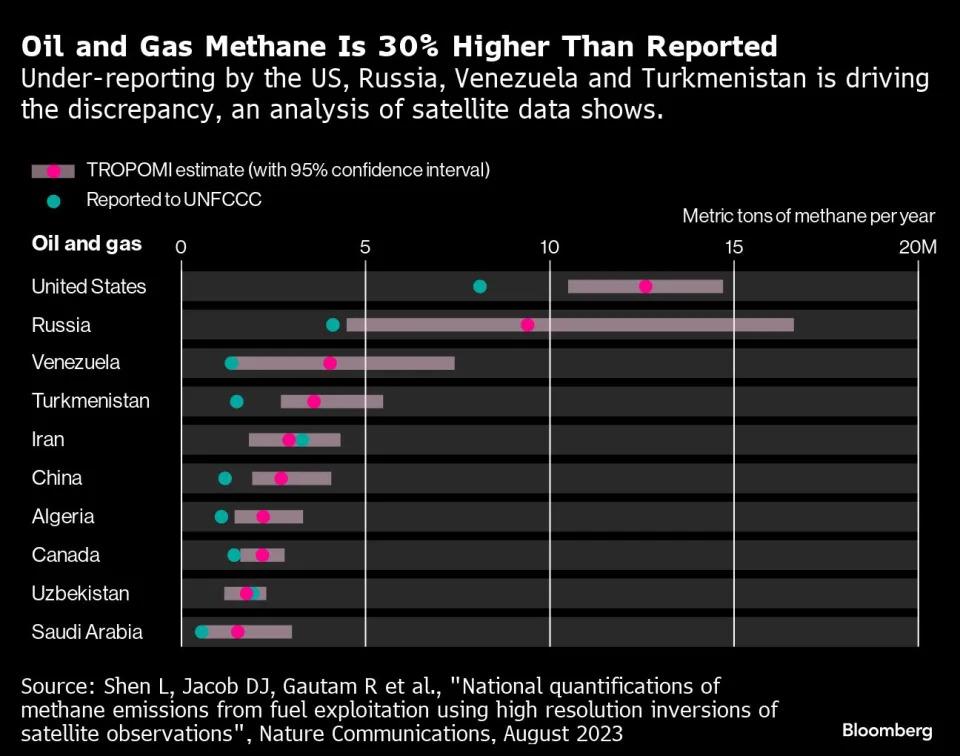
(Bloomberg) -- European Union negotiators struck a deal to curb methane releases from fossil-fuel infrastructure and plotted a course to monitor and limit the emissions associated with imported energy sources.
EU lawmakers and member states reached a provisional political agreement to require energy companies to regularly check infrastructure including wells and pipelines for leaks of methane, the Council of the EU and the European Council said in a statement. The potent greenhouse gas — the main component of natural gas — has more than 80 times the warming power of carbon dioxide during its first two decades in the atmosphere and is responsible for approximately 30% of the Earth’s warming.
The deal is notable because monitoring, reporting and verification measures will eventually be applied to imports, which account for more than 90% of the 27-nation bloc’s oil and gas. The agreement is the latest in a series of global efforts targeting methane cuts, which scientists say is one of the cheapest and most powerful ways to reduce rising temperatures in the short term.
The new EU rules could eventually impact where it sources its oil and gas, and operators that are unable or unwilling to halt their methane emissions may find themselves with shrinking market share. Releases of methane from pipeline gas tend to be higher than for LNG, mainly due to activities in producing countries, according to Berkley Research Group.
Negotiators agreed that by 2027, importers will have to demonstrate equivalent monitoring, reporting and verification requirements at production level. After the regulations have been in force for three years, the European Commission, the bloc’s executive branch, would propose placing methane intensity classes for crude oil, natural gas and coal at the level of the producer or company.
Read more: Europe Warns Methane Polluters as Bloc Pushes to Slash Emissions
By 2030 importers will have to pay a financial penalty for imports that are above a certain methane intensity threshold, and new supply contracts will have to take into account the rules. The deal comes two weeks before countries meet in Dubai for the COP28 climate summit, where tackling methane is likely to be one of the main issues.
“The extension to imports, which was my main priority in the parliament’s position, will have repercussions worldwide,” said Jutta Paulus, the green lawmaker who led negotiations from the European parliament. “I am very pleased that we will go to the UN climate conference in Dubai with full hands.”
Methane is the primary component of natural gas but it also leaks across coal and oil supply chains, sometimes without the knowledge of operators. However, producers do often choose to release the gas into the atmosphere if it’s more expensive to contain than trap and bring to market.
“Considering the prospect of an import standard was nothing more than a dream a year ago, this outcome is a major step forward,” said Brandon Locke, Europe policy manager for methane pollution prevention at Clean Air Task Force, a climate non-profit. “While we would have preferred a faster timeline to reduce emissions before 2030, this agreement will nonetheless go a long way to dramatically cut global methane pollution.”
Scientists using satellite observations have consistently found that operators and governments significantly under report methane emissions from fossil fuel production. A study published in Nature Communications in August that relied on satellite observations found that observed methane releases from global oil and gas operations are 30% higher than estimates provided by countries to the United Nations.
The world’s four largest oil and gas emitters — the US, Russia, Venezuela and Turkmenistan — account for most of the overall discrepancy, according to the report.
China, the world’s largest emitter of methane, said earlier this month it will boost monitoring, reporting and data transparency to reduce releases of the greenhouse gas. American officials were negotiating a deal to help Turkmenistan curb its vast methane emissions, Bloomberg Green reported in June.
Bloomberg Businessweek
Timothy Gardner
Wed, November 15, 2023
By Timothy Gardner
WASHINGTON (Reuters) -The U.S. and more than a dozen countries and groups have forged a working group to advance efforts to measure greenhouse gas emissions across the natural gas supply chain to cut global output of the pollution blamed for climate change, the Energy Department said on Wednesday.
The MMRV Working Group aims to advance efforts to measure, monitor, report and verify emissions of methane, carbon dioxide and other greenhouse gases. It seeks to do so for the entire gas supply chain including production, processing, transport, liquefaction, and distribution of the fuel.
Participants are: Australia, Brazil, Canada, Colombia, East Mediterranean Gas Forum, European Commission, France, Germany, Italy, Japan, Mozambique, Norway, South Korea, Britain and the U.S.
Brad Crabtree, assistant secretary of fossil energy and carbon management at the Energy Department, said there is a pressing need to provide comparable, reliable information on emissions cuts by gas producers and exporters to global markets.
"It's really critical that we develop on a global basis a framework that is agreed to and supported by both importing countries and exporting countries, one on the governmental side, but also has the investment and support of industry and other stakeholders," Crabtree told Reuters.
In the first half of this year, the U.S. was the world's largest exporter of gas that is super-chilled so it can be transported by tanker in the form of liquefied natural gas, or LNG.
Some gas drillers are working on cutting their climate impact, including the marketing of so-called certified gas they say aims to be lower in emissions through actions such as plugging leaks or buying carbon offsets.
Certified gas is often sold at a premium. Some environmentalists and other critics have slammed the efforts as attempts to "green wash" a fossil fuel.
The MMRV agreement comes as the European Union reached a deal to impose methane emissions limits on oil and gas imports from 2030, a move that pressures international fossil fuel suppliers including the U.S. to cut leaks of the potent planet-warming gas.
Crabtree said the U.S. welcomes efforts by countries that import LNG to establish methane regulations as a helpful market signal.
He said there will be talks next year on how developing countries in the group can measure their emissions from gas. "We recognize that not all countries are in the same place," on their ability to measure and verify.
(Reporting by Timothy Gardner, Editing by Franklin Paul and Marguerita Choy)
Reuters
Wed, November 15, 2023
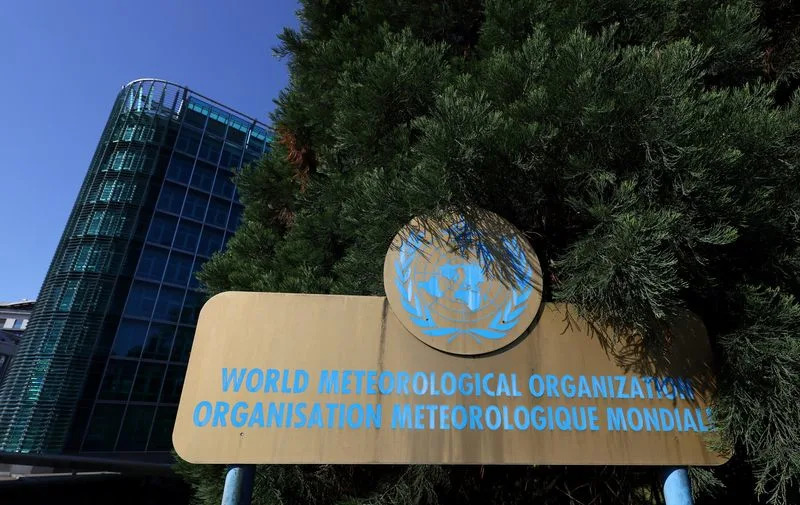
WMO headquarters are pictured before a news conference to launch state of global climate report at the United Nations in Geneva
GENEVA (Reuters) -The concentration of greenhouse gases in the atmosphere reached a record high last year, the World Meteorological Organization (WMO) said on Wednesday, warning there was "no end in sight" to the trend.
The warning comes weeks before world leaders are due to gather in Dubai for the annual U.N. climate conference COP28, which will see governments push for greater climate action, including a possible phase-out of fossil fuels before 2050.
In 2022, global average concentrations of carbon dioxide were a full 50% above the pre-industrial era for the first time, the U.N. weather agency said.
"Despite decades of warnings from the scientific community, thousands of pages of reports and dozens of climate conferences, we are still heading in the wrong direction," said WMO Secretary-General Petteri Taalas.
Taalas said higher concentrations of greenhouse gases would be accompanied by more extreme weather events, including intense heat and rainfall, ice melt, higher sea levels, as well as ocean heat and acidification.
"About half of the planet has been facing an increase of flooding events, and one third of the planet has been facing an increase of drought events," Taalas said. "And this negative trend will continue until 2060s."
"We must reduce the consumption of fossil fuels as a matter of urgency," he said.
Methane concentrations in the atmosphere also increased, and levels of nitrous oxide, another greenhouse gas, saw the highest year-on-year increase on record between 2021 and 2022, WMO said.
Greenhouse gases are responsible for warming the planet and triggering extreme weather events. Unlike emissions which can be cut, much of the carbon dioxide emitted decades ago remains in the atmosphere and activates slow processes like the increase of the sea level.
"It takes thousands of years to remove carbon from the system once it's emitted into the atmosphere," Taalas said.
A separate UN report published on Tuesday said that governments were making insufficient progress in slashing greenhouse gas emissions to avert the worst impacts of global warming.
(Reporting by Gabrielle Tétrault-Farber; Editing by Christina Fincher and Bernadette Baum)
Wed, November 15, 2023

WMO headquarters are pictured before a news conference to launch state of global climate report at the United Nations in Geneva
GENEVA (Reuters) -The concentration of greenhouse gases in the atmosphere reached a record high last year, the World Meteorological Organization (WMO) said on Wednesday, warning there was "no end in sight" to the trend.
The warning comes weeks before world leaders are due to gather in Dubai for the annual U.N. climate conference COP28, which will see governments push for greater climate action, including a possible phase-out of fossil fuels before 2050.
In 2022, global average concentrations of carbon dioxide were a full 50% above the pre-industrial era for the first time, the U.N. weather agency said.
"Despite decades of warnings from the scientific community, thousands of pages of reports and dozens of climate conferences, we are still heading in the wrong direction," said WMO Secretary-General Petteri Taalas.
Taalas said higher concentrations of greenhouse gases would be accompanied by more extreme weather events, including intense heat and rainfall, ice melt, higher sea levels, as well as ocean heat and acidification.
"About half of the planet has been facing an increase of flooding events, and one third of the planet has been facing an increase of drought events," Taalas said. "And this negative trend will continue until 2060s."
"We must reduce the consumption of fossil fuels as a matter of urgency," he said.
Methane concentrations in the atmosphere also increased, and levels of nitrous oxide, another greenhouse gas, saw the highest year-on-year increase on record between 2021 and 2022, WMO said.
Greenhouse gases are responsible for warming the planet and triggering extreme weather events. Unlike emissions which can be cut, much of the carbon dioxide emitted decades ago remains in the atmosphere and activates slow processes like the increase of the sea level.
"It takes thousands of years to remove carbon from the system once it's emitted into the atmosphere," Taalas said.
A separate UN report published on Tuesday said that governments were making insufficient progress in slashing greenhouse gas emissions to avert the worst impacts of global warming.
(Reporting by Gabrielle Tétrault-Farber; Editing by Christina Fincher and Bernadette Baum)
‘We aren’t where we need to be’ on climate change, warns BCG global chair Rich Lesser
Alan Murray, Nicholas Gordon
Wed, November 15, 2023
Good morning.
With COP28 three weeks away, Fortune assembled a small group of CEOs yesterday, in partnership with BCG, to explore how the private sector can accelerate efforts to address climate change. A few excerpts:
“The bottom line is, whatever measures of progress you look at, we aren’t where we need to be…Only 20% of the top 1,000 companies have a target to get to 1.5 degree centigrade. If you say, well, any net zero target will count, then you get to 60% of companies. But you still have 40% of companies with no net zero target.”
—Rich Lesser, Global Chair, BCG
“We believe we are on a 2.4 degree centigrade warming trajectory…That’s better than the UN would say, but obviously a lot worse than the trajectory that, as a world, we feel we should be on…From an investment standpoint, we think that there’s around $700 billion per annum available right now. It should really be double that.”
—Richard Mattison, Vice Chair, S&P Global
“What we are trying to do now is help our suppliers, and in some cases also our customers, come along with us in this process (of getting to net zero)…Then we need to create a framework that excites our people and that gives them a reason to make all those trade-offs in everyday decisions…But I think we have the foundation, and what I am seeing is that we can now really accelerate fast.”
—Ramon Laguarta, CEO, PepsiCo
“If you’ve got to address climate, you’ve got to address the plastic waste problem in this world…We’ve got 350 million tons of plastic waste being thrown away every year, and only 9% of it is being recycled today.…Our technology can take low quality plastic waste, we can unzip it, back to the building blocks, which is the step before polymer, purify it, make the polymer, and create a continuous loop…with 88% lower carbon footprint than in the current process.”
—Mark Costa, CEO, Eastman Chemical
“The health care sector actually produces 5% of global carbon emissions, which is more than the airline industry…So it’s a big job, but it is actually happening, and it is mostly due to private-to-private collaboration.”
—Pascal Soriot, CEO, AstraZeneca
“We’d like to see the private sector play a more active role in adaptation to the impact of climate change. It is still vastly underfunded. We already have situations where communities have to change how they live or they work because, frankly, where they live now and what they used to be doing is not possible anymore.”
—Janti Soeripto, CEO, Save the Children US
We’ll explore these topics further at the Fortune Global Forum in Abu Dhabi Nov. 27-29, and then at a pre-COP dinner in Dubai the evening of the 29th. You can get more information here…or shoot me a note if you are interested in attending.
Rosie Frost
Tue, November 14, 2023

A new analysis of national climate plans ahead of COP28 has found that they are still insufficient to keep global temperature rise within Paris Agreement limits.
Under countries’ current plans, greenhouse gas emissions will increase by 9 per cent by 2030 compared to 2010 levels. But emissions need to fall by 45 per cent compared to 2010 levels by the end of this decade to limit global temperature rise to 1.5C.
“The world is failing to get a grip on the climate crisis,” UN secretary general Antonio Guterres says.
“That is the message of the UNFCCC’s latest report which provides yet more evidence that the world remains massively off track to limiting global warming to 1.5 degrees Celsius and avoiding the worst of climate catastrophe.”
COP28: EU pledges 'substantial' financial contribution to climate damage fund
Shell is suing Greenpeace for €2 million after activists boarded oil vessel near Canary Islands
Tue, November 14, 2023

A new analysis of national climate plans ahead of COP28 has found that they are still insufficient to keep global temperature rise within Paris Agreement limits.
Under countries’ current plans, greenhouse gas emissions will increase by 9 per cent by 2030 compared to 2010 levels. But emissions need to fall by 45 per cent compared to 2010 levels by the end of this decade to limit global temperature rise to 1.5C.
“The world is failing to get a grip on the climate crisis,” UN secretary general Antonio Guterres says.
“That is the message of the UNFCCC’s latest report which provides yet more evidence that the world remains massively off track to limiting global warming to 1.5 degrees Celsius and avoiding the worst of climate catastrophe.”
COP28: EU pledges 'substantial' financial contribution to climate damage fund
Shell is suing Greenpeace for €2 million after activists boarded oil vessel near Canary Islands
Governments are taking ‘baby steps’ on climate action
The report analysed the climate action plans, or Nationally Determined Contributions (NDCs), of the 195 signatories of the Paris Agreement. It includes around 20 new or updated plans submitted up until 25 September this year.
Even with increased efforts by some countries, it shows that much more action is needed now to avoid the worst impacts of climate change.
The fall to a 9 per cent increase in emissions is only a marginal improvement on the 11 per cent seen in last year’s report and the 14 per cent from 2021.
Executive secretary of the UN Framework Convention on Climate Change (UNFCCC) Simon Stiell says governments are making “baby steps” towards averting crisis.

The first Global Stocktake - a report card on progress towards Paris Agreement goals - will likely be one of the major focuses of COP28. -
REUTERS/Amr Alfiky/File Photo
“Today’s synthesis report of national climate plans underscores the need for us to act with greater ambition and urgency to meet the goals of the Paris Agreement - there is simply no time left for delays,” says COP28 President and chief of the UAE's state oil firm Sultan Al Jaber.
“COP28 must be a historic turning point in this critical decade for parties to seize the moment of the Global Stocktake to commit to raise their ambition and to unite, act and deliver outcomes that keep 1.5C within reach while leaving no one behind.”
Will 2023 be the hottest year yet? Climate scientists are ‘virtually certain’ after October record
'Historic result': European Parliament and member states reach deal on Nature Restoration Law
“Today’s synthesis report of national climate plans underscores the need for us to act with greater ambition and urgency to meet the goals of the Paris Agreement - there is simply no time left for delays,” says COP28 President and chief of the UAE's state oil firm Sultan Al Jaber.
“COP28 must be a historic turning point in this critical decade for parties to seize the moment of the Global Stocktake to commit to raise their ambition and to unite, act and deliver outcomes that keep 1.5C within reach while leaving no one behind.”
Will 2023 be the hottest year yet? Climate scientists are ‘virtually certain’ after October record
'Historic result': European Parliament and member states reach deal on Nature Restoration Law
Will the Global Stocktake help improve climate plans?
The first Global Stocktake - a report card on progress towards Paris Agreement goals - will likely be one of the major focuses of COP28 in Dubai this year. It will inform the next round of NDCs that countries will have to put forward by 2025.
“The Global Stocktake report released by UN Climate Change this year clearly shows that progress is too slow,” says Stiell.
“But it also lays out the vast array of tools and solutions put forward by countries. Billions of people expect to see their governments pick up this toolbox and put it to use.”
The Global Stocktake report released by UN Climate Change this year clearly shows that progress is too slow.
The UNFCCC’s analysis indicates that emissions will fall by 2 per cent by the end of the decade compared to what they were in 2019. While this shows that emissions are likely to peak by 2030, it still doesn't demonstrate the rapid downward trend science says is needed to avoid catastrophic warming.
And, to achieve this peak, all elements of countries’ NDC - which outline the specific efforts and actions they are taking to cut greenhouse gases and adapt to climate change - need to be implemented. That includes conditional ones which depend on access to finance, technology and international cooperation.
Guterres says it's time for a “climate ambition supernova in every country, city and sector”.
“Net zero timelines must be accelerated so that developed countries get there as close as possible to 2040 and emerging economies as close as possible to 2050.”
Renewable energy capacity must be boosted, he adds, coal and fossil fuels must be phased out. Developed countries also need to rebuild trust by delivering on climate finance pledges.
“COP28 must be the place to urgently close the climate ambition gap,” according to Guterres.
China and the US pledge to step up climate efforts ahead of Biden-Xi summit and UN meeting
KEN MORITSUGU
Updated Wed, November 15, 2023

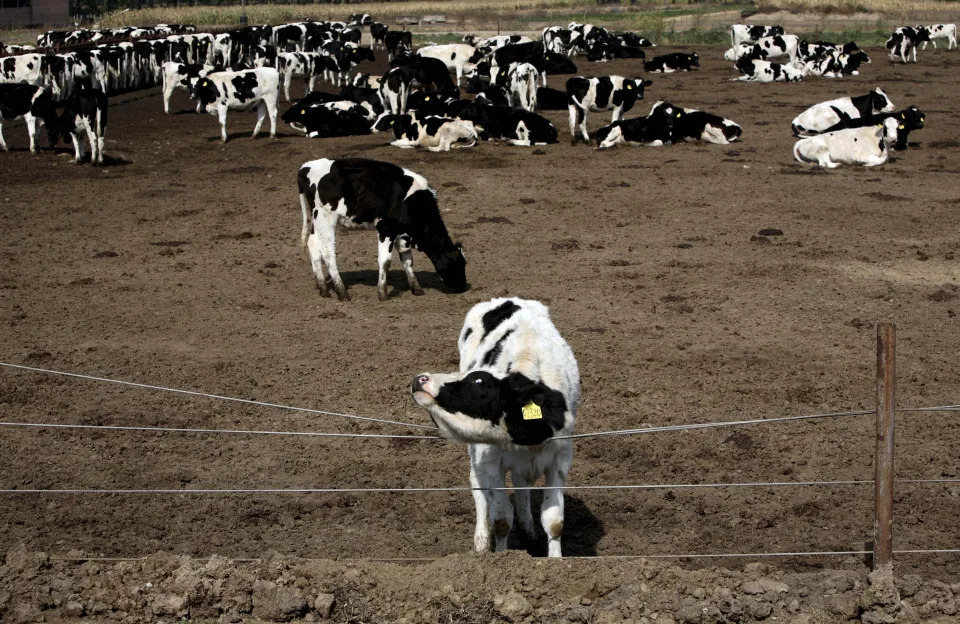

A milk cow rests at a milk farm in Yuanshi, northern China's Hebei province, on Sept. 20, 2008. China and the U.S. have pledged to accelerate their efforts to address climate change ahead of a major U.N. meeting on the issue, making a commitment to take steps to reduce emissions of methane and other greenhouse gases besides carbon dioxide.
(AP Photo/Ng Han Guan, File)
BEIJING (AP) — China and the U.S. have pledged to accelerate their efforts to address climate change ahead of a major U.N. meeting on the issue, making a commitment to take steps to reduce emissions of methane and other greenhouse gases besides carbon dioxide.
The joint announcement came on the eve of a summit between Presidents Joe Biden and Xi Jinping that is aimed at stabilizing the rocky U.S.-China relationship.
Cooperation between the world's two biggest emitters of greenhouse gases is considered vital to the success of the U.N. climate talks opening in two weeks in Dubai. It wasn't clear earlier this year whether the two governments would cooperate, given a sharp deterioration in ties over other issues including technology, Taiwan and Russia's war in Ukraine.
Both countries “are aware of the important role they play” and “will work together ... to rise up to one of the greatest challenges of our time,” they said in a statement released Wednesday in Beijing and Tuesday evening in Washington.
They reiterated a pledge made by the Group of 20 nations, of which both are members, to pursue efforts to triple global renewable energy capacity by 2030. Chinese companies are looking to sell wind and solar power equipment abroad, having invested heavily in factories for their manufacture.
“If the two countries can work together to shore up the buy-in for the target, that will very considerably smooth the way for having it adopted,” said Lauri Myllyvirta, the lead analyst at the Centre for Research on Energy and Clean Air.
The U.S. and China agreed to restart talks on energy policies and launch a working group on enhancing climate action in what they called “the critical decade of the 2020s.” Experts say the world needs to act now to have any chance of achieving the agreed-upon goal of limiting the average increase in global temperatures to well below 2 degrees Celsius (3.6 Fahrenheit).
A climate expert described the agreement by both countries to include methane in their next climate action plans as “a major step."
“Methane has been notably absent from China’s previous commitment” under the 2015 climate treaty known as the Paris Agreement, said David Waskow, the international climate director at the World Resources Institute. He noted that China is the world’s largest emitter of methane and that “serious actions to curb this gas is essential for slowing global warming in the near-term.”
The Chinese government issued an action plan last week to control methane emissions, including the development of an accounting and reporting system for emissions. Major emitters include coal mines, oil and gas fields, farms, landfills and sewage treatment plants.
Myllyvirta said the plan is very generic without any measurable emissions targets, so “follow-up on that front will be important.”
The U.S. and China also said that together with the United Arab Emirates, they would host a meeting on methane and other greenhouse gases during the upcoming U.N. talks in Dubai.
Waskow expressed disappointment that the joint statement didn't pledge to phase out fossil fuels. That wasn't a surprise — even as China has rapidly expanded in wind and solar power, it has encouraged the construction of coal power plants, which it sees as a more reliable source of power for periods of peak demand.
The government announced last week that it would begin making “capacity payments” next year to coal power plant operators to keep them open and available for use, even as revenues fall as their electricity production is increasingly replaced by renewable energy.
The U.S.-China joint statement welcomed climate cooperation between states, provinces and cities and said the two countries would hold a high-level event on such cooperation in the first half of 2024.
The governor of California, Gavin Newsom, made a weeklong visit to China last month to promote joint climate efforts in several cities and provinces.
Associated Press researcher Yu Bing in Beijing contributed to this report.
EU agrees law to hit fossil fuel imports with methane emissions limit
BEIJING (AP) — China and the U.S. have pledged to accelerate their efforts to address climate change ahead of a major U.N. meeting on the issue, making a commitment to take steps to reduce emissions of methane and other greenhouse gases besides carbon dioxide.
The joint announcement came on the eve of a summit between Presidents Joe Biden and Xi Jinping that is aimed at stabilizing the rocky U.S.-China relationship.
Cooperation between the world's two biggest emitters of greenhouse gases is considered vital to the success of the U.N. climate talks opening in two weeks in Dubai. It wasn't clear earlier this year whether the two governments would cooperate, given a sharp deterioration in ties over other issues including technology, Taiwan and Russia's war in Ukraine.
Both countries “are aware of the important role they play” and “will work together ... to rise up to one of the greatest challenges of our time,” they said in a statement released Wednesday in Beijing and Tuesday evening in Washington.
They reiterated a pledge made by the Group of 20 nations, of which both are members, to pursue efforts to triple global renewable energy capacity by 2030. Chinese companies are looking to sell wind and solar power equipment abroad, having invested heavily in factories for their manufacture.
“If the two countries can work together to shore up the buy-in for the target, that will very considerably smooth the way for having it adopted,” said Lauri Myllyvirta, the lead analyst at the Centre for Research on Energy and Clean Air.
The U.S. and China agreed to restart talks on energy policies and launch a working group on enhancing climate action in what they called “the critical decade of the 2020s.” Experts say the world needs to act now to have any chance of achieving the agreed-upon goal of limiting the average increase in global temperatures to well below 2 degrees Celsius (3.6 Fahrenheit).
A climate expert described the agreement by both countries to include methane in their next climate action plans as “a major step."
“Methane has been notably absent from China’s previous commitment” under the 2015 climate treaty known as the Paris Agreement, said David Waskow, the international climate director at the World Resources Institute. He noted that China is the world’s largest emitter of methane and that “serious actions to curb this gas is essential for slowing global warming in the near-term.”
The Chinese government issued an action plan last week to control methane emissions, including the development of an accounting and reporting system for emissions. Major emitters include coal mines, oil and gas fields, farms, landfills and sewage treatment plants.
Myllyvirta said the plan is very generic without any measurable emissions targets, so “follow-up on that front will be important.”
The U.S. and China also said that together with the United Arab Emirates, they would host a meeting on methane and other greenhouse gases during the upcoming U.N. talks in Dubai.
Waskow expressed disappointment that the joint statement didn't pledge to phase out fossil fuels. That wasn't a surprise — even as China has rapidly expanded in wind and solar power, it has encouraged the construction of coal power plants, which it sees as a more reliable source of power for periods of peak demand.
The government announced last week that it would begin making “capacity payments” next year to coal power plant operators to keep them open and available for use, even as revenues fall as their electricity production is increasingly replaced by renewable energy.
The U.S.-China joint statement welcomed climate cooperation between states, provinces and cities and said the two countries would hold a high-level event on such cooperation in the first half of 2024.
The governor of California, Gavin Newsom, made a weeklong visit to China last month to promote joint climate efforts in several cities and provinces.
Associated Press researcher Yu Bing in Beijing contributed to this report.
EU agrees law to hit fossil fuel imports with methane emissions limit
Updated Wed, November 15, 2023
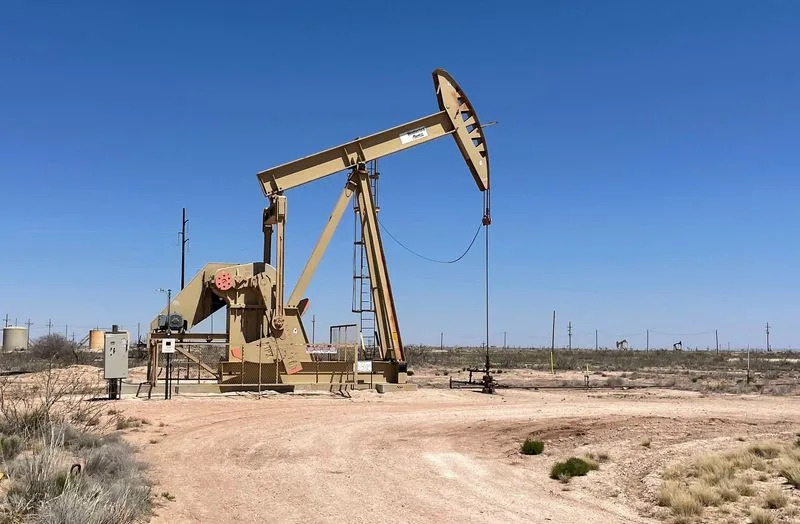
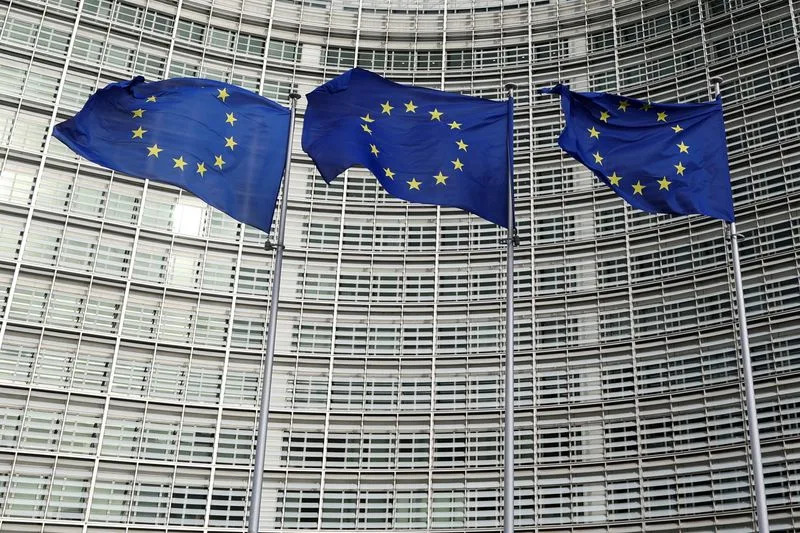
By Kate Abnett
(Reuters) - The European Union reached a deal on Wednesday on a law to place methane emissions limits on Europe's oil and gas imports from 2030, pressuring international suppliers to clamp down on leaks of the potent greenhouse gas.
Methane is the second-biggest cause of climate change after carbon dioxide, and in the short term has a far higher warming effect. Rapid cuts in methane emissions this decade are crucial if the world is to avoid severe climate change.
After all-night talks, negotiators from EU member states and the European Parliament agreed to impose "maximum methane intensity values" by 2030 on producers abroad sending fossil fuels into Europe, the council of the EU, which represents member states, said in a statement.
The import rules are likely to hit major gas suppliers which include the U.S., Algeria and Russia. Moscow slashed deliveries to Europe last year and has since been replaced as Europe's biggest pipeline gas supplier by Norway, whose supply has among the world's lowest methane intensity.
"Finally, the EU tackles the second most important greenhouse gas with ambitious measures," said Jutta Paulus, the EU Parliament's co-lead negotiator, adding that the law "will have repercussions worldwide".
Paulus told reporters importers will face financial penalties if they buy from foreign suppliers that don't comply with the limit - effectively imposing a fee on non-compliant fuels.
The methane standard would be mandatory for supply contracts signed after the law enters into force, likely later this year, after the European Parliament and EU countries give it final approval.
That step is usually a formality that waves through pre-agreed deals.
The EU's exact methane emissions limit will be set out by the European Commission before it applies.
Methane leaches into the atmosphere from leaky pipelines and infrastructure at oil and gas fields.
The regulation also introduces new requirements for the oil, gas and coal sectors to measure, report and verify methane emissions.
The deal obliges oil and gas producers in Europe to regularly check for and fix leaks of the potent greenhouse gas in their operations.
It also bans most cases of flaring and venting, when companies intentionally burn off or release unwanted methane into the atmosphere, from 2025 or 2027 depending on the type of infrastructure.
(Reporting by Akanksha Khushi, Shubham Kalia in Bengaluru and Kate Abnett in Brussels. Editing by Gerry Doyle, Miral Fahmy and Jan Harvey)
EU reaches deal to reduce highly polluting methane gas emissions from the energy sector
Associated Press
Wed, November 15, 2023
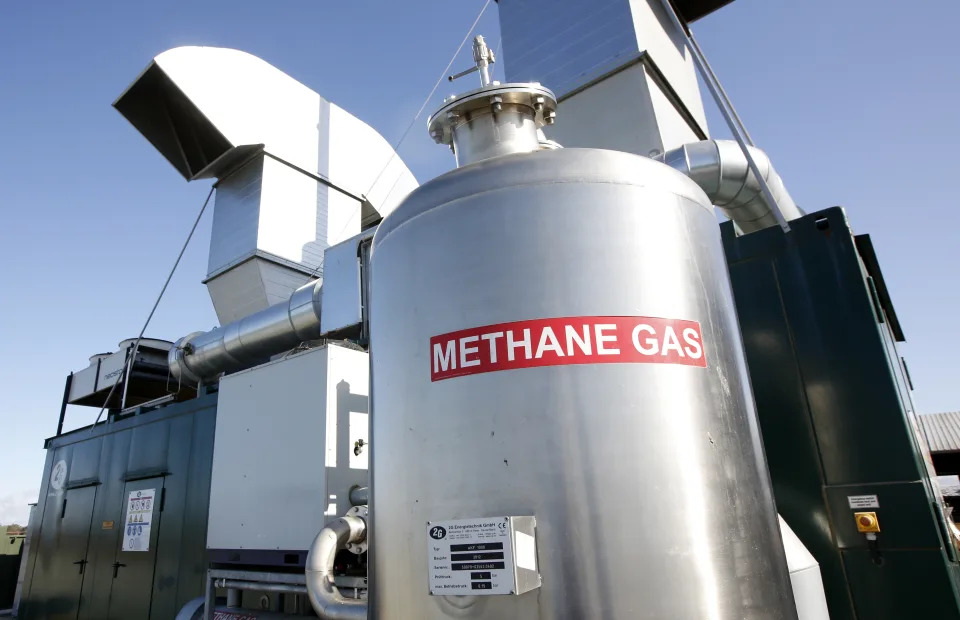
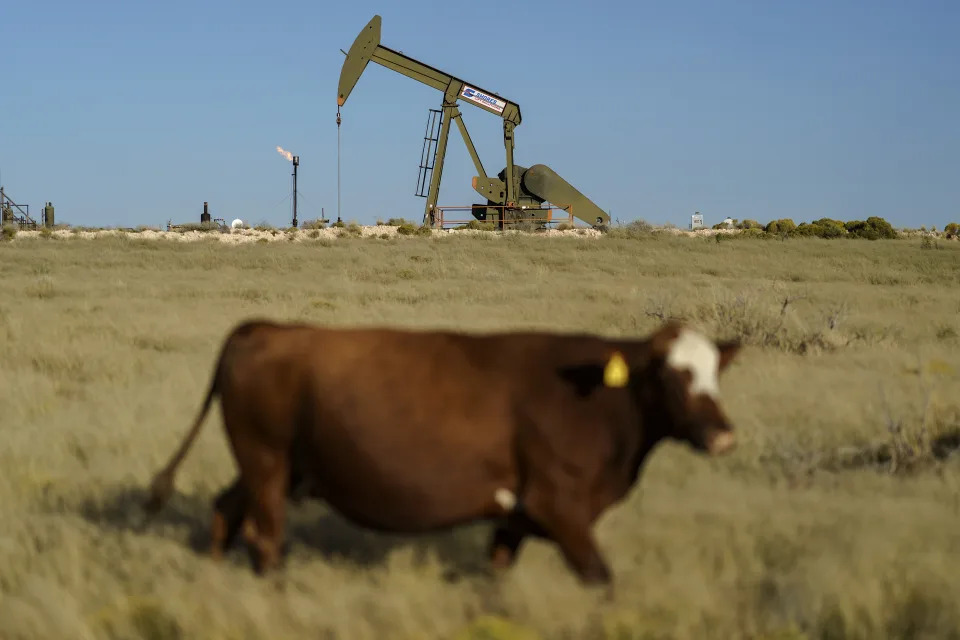
A cow walks through a field as an oil pumpjack and a flare burning off methane and other hydrocarbons in the background in the Permian Basin in Jal, N.M.,on Oct. 14, 2021. European Union negotiators reached a deal on Wednesday, Nov. 15, 2023, to reduce highly polluting methane gas emissions from the energy sector across the 27-nation bloc.One of the biggest causes of climate change is methane gas emissions, second only to carbon dioxide, and the gas also causes serious health problems. Most emissions come from the energy, agriculture and waste sectors.
(AP Photo/David Goldman, File)
BRUSSELS (AP) — European Union negotiators reached a deal on Wednesday to reduce highly polluting methane gas emissions from the energy sector across the 27-nation bloc.
According to experts, one of the biggest causes of climate change is methane gas emissions — second only to carbon dioxide. The gas also causes serious health problems.
Most emissions come from the energy, agriculture and waste sectors.
Under the provisional agreement announced just weeks before the COP28 climate conference, the fossil gas, oil and coal industry will be forced to “properly measure, monitor, report and verify their methane emissions according to the highest monitoring standards, and take action to reduce them,” said the European Commission, the EU's executive arm.
The deal needs to be formally approved by both the European Parliament and the Council, which represents member states, before the new legislation enters into force.
This came as China and the United States pledged to accelerate their efforts to address climate change ahead of a major United Nations meeting on the issue, making a commitment to take steps to reduce emissions of methane and other greenhouse gases besides carbon dioxide.
The U.S., the EU and other nations have previously committed to reduce overall methane emissions worldwide by 30% by 2030.
The Commission said the compromise requires operators to report about quantification and measurements of methane emissions at source level, and forces oil and gas companies to detect and repair methane leaks on EU soil. It also bans routine venting and flaring, which release methane in the atmosphere, and limits venting from thermal coal mines from 2027, with stricter conditions introduced after 2031.
“It requires companies in the oil, gas and coal sectors to carry out an inventory of closed, inactive, plugged and abandoned assets, such as wells and mines, to monitor their emissions and to adopt a plan to mitigate these emissions as soon as possible,” the Commission added.
The EU Methane Regulation for the energy sector is part of the so-called European Green Deal that seeks to establish the world’s most ambitious climate and biodiversity targets.
Since the EU imports large quantities of oil, gas and coal, the deal also requires from 2027 that new import contracts can only be sealed “if the same monitoring, reporting and verification obligations are applied by exporters as for EU producers,” the Commission said.
BRUSSELS (AP) — European Union negotiators reached a deal on Wednesday to reduce highly polluting methane gas emissions from the energy sector across the 27-nation bloc.
According to experts, one of the biggest causes of climate change is methane gas emissions — second only to carbon dioxide. The gas also causes serious health problems.
Most emissions come from the energy, agriculture and waste sectors.
Under the provisional agreement announced just weeks before the COP28 climate conference, the fossil gas, oil and coal industry will be forced to “properly measure, monitor, report and verify their methane emissions according to the highest monitoring standards, and take action to reduce them,” said the European Commission, the EU's executive arm.
The deal needs to be formally approved by both the European Parliament and the Council, which represents member states, before the new legislation enters into force.
This came as China and the United States pledged to accelerate their efforts to address climate change ahead of a major United Nations meeting on the issue, making a commitment to take steps to reduce emissions of methane and other greenhouse gases besides carbon dioxide.
The U.S., the EU and other nations have previously committed to reduce overall methane emissions worldwide by 30% by 2030.
The Commission said the compromise requires operators to report about quantification and measurements of methane emissions at source level, and forces oil and gas companies to detect and repair methane leaks on EU soil. It also bans routine venting and flaring, which release methane in the atmosphere, and limits venting from thermal coal mines from 2027, with stricter conditions introduced after 2031.
“It requires companies in the oil, gas and coal sectors to carry out an inventory of closed, inactive, plugged and abandoned assets, such as wells and mines, to monitor their emissions and to adopt a plan to mitigate these emissions as soon as possible,” the Commission added.
The EU Methane Regulation for the energy sector is part of the so-called European Green Deal that seeks to establish the world’s most ambitious climate and biodiversity targets.
Since the EU imports large quantities of oil, gas and coal, the deal also requires from 2027 that new import contracts can only be sealed “if the same monitoring, reporting and verification obligations are applied by exporters as for EU producers,” the Commission said.
EU negotiators reach deal on methane emission curbs
AFP
Wed, November 15, 2023
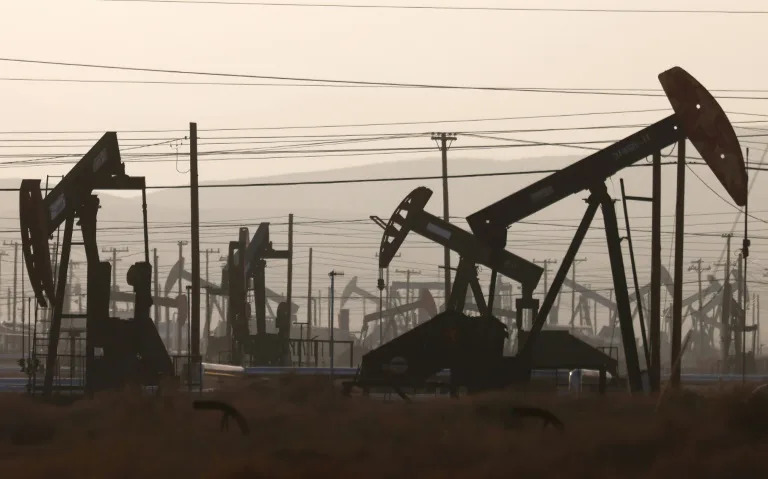
The proposed EU rules would require the fossil fuel energy sector to have new measures to track and monitor methane gas emissions, and to prevent leaks (MARIO TAMA)
Negotiators for the EU's member states and lawmakers on Wednesday reached a deal on new rules to curb methane emissions which would put new reporting requirements on the coal, gas and oil industry.
"The text represents a crucial contribution to climate action as methane is a powerful greenhouse gas, second only to carbon dioxide in its overall contribution to climate change and responsible for a third of current climate warming," said Teresa Ribera, Spain's ecological transition minister.
The provisional deal, which still needs to be formally approved to become law, was struck just two weeks before the start of COP28, the UN climate summit in Dubai.
It requires the fossil fuel energy sector to have new measures to track and monitor methane gas emissions, and to prevent leaks. It bans routine venting and flaring and limits non-routing flaring and venting to only when it is unavoidable.
Importantly, it also calls for methane monitoring measures on imports of oil, gas and coal into the European Union, to be introduced in three phases.
The first phase would set up a global monitoring tool and a "super emitter rapid reaction mechanism".
The follow-up phases would, by 2027, introduce monitoring, reporting and verification measures for imports on the same basis as those applied inside the EU, and "maximum methane intensity values" by 2030.
EU member states would have the power to levy fines in case of violation.
The European Commission hailed Wednesday's agreement as "crucial" to the EU's fight against climate change
It says that, over a century, methane has an effect 28 times greater than that of carbon dioxide on global warming, and over a 20-year timescale it is 84 times more potent.
EU climate agreement targets methane emissions, aims to restrict oil, gas imports
A.L. Lee
Wed, November 15, 2023

The European Union reached a deal to pass new climate legislation aimed at reducing methane emissions that would impose new import restrictions on foreign energy suppliers, including the United States. File photo by Orestis Panagiotou/EPA-EFE
Nov. 15 (UPI) -- Ministers of the European Union reached a deal on Wednesday to pass new climate legislation aimed at reducing methane emissions, while imposing new import restrictions on foreign energy suppliers, including the United States.
The European Parliament and the European Council, which collectively serve as the primary governing bodies of the 27-nation bloc, reached consensus on Europe's first provisional regulations to curtail harmful gas emissions from fossil fuels.
The agreement was also critical to delivering on climate goals set under the European Green Deal of 2020, which aims to reduce net greenhouse gas emissions by at least 55% before 2030, the European Commission said in statement praising the deal.
There was no visible opposition to the bill as it sailed through EU ministerial scrutiny, but the proposal still faces final approval by both the Parliament and the EU heads of state.
The proposed law would force the oil, gas and coal industry to continually evaluate methane emissions, conduct regular atmospheric monitoring for the presence of greenhouse gases, and prohibit controlled burns of natural gases at refineries and other work facilities.
By 2027, the legislation would also ban pollutant gases from being released directly into the atmosphere without combustion, a process known as "venting."
Another major provision in the law targets oil and gas imports, which currently constitute about 80% of the EU's annual consumption, forcing global companies to meet tougher emissions standards on par with the EU's before distributors are permitted to move fuel into the region.
Wednesday's agreement materialized two weeks ahead of the COP28 summit, where EU leaders plan to put pressure on international partners to adopt similar measures to reduce methane emissions.
The legislation also comes two years after the U.S. and Brussels established the Global Methane Pledge at the COP26 Summit in Glasgow, which noted the role of hydrocarbon gases in contributing to a 30% increase in global temperatures over the past two decades.
Members of the Council and Parliament have been pushing the European Commission to adopt a policy that would establish methane intensity limits for fossil fuel imports and impose financial penalties on companies that fail to comply with the rules starting in 2030.
Wed, November 15, 2023

The European Union reached a deal to pass new climate legislation aimed at reducing methane emissions that would impose new import restrictions on foreign energy suppliers, including the United States. File photo by Orestis Panagiotou/EPA-EFE
Nov. 15 (UPI) -- Ministers of the European Union reached a deal on Wednesday to pass new climate legislation aimed at reducing methane emissions, while imposing new import restrictions on foreign energy suppliers, including the United States.
The European Parliament and the European Council, which collectively serve as the primary governing bodies of the 27-nation bloc, reached consensus on Europe's first provisional regulations to curtail harmful gas emissions from fossil fuels.
The agreement was also critical to delivering on climate goals set under the European Green Deal of 2020, which aims to reduce net greenhouse gas emissions by at least 55% before 2030, the European Commission said in statement praising the deal.
There was no visible opposition to the bill as it sailed through EU ministerial scrutiny, but the proposal still faces final approval by both the Parliament and the EU heads of state.
The proposed law would force the oil, gas and coal industry to continually evaluate methane emissions, conduct regular atmospheric monitoring for the presence of greenhouse gases, and prohibit controlled burns of natural gases at refineries and other work facilities.
By 2027, the legislation would also ban pollutant gases from being released directly into the atmosphere without combustion, a process known as "venting."
Another major provision in the law targets oil and gas imports, which currently constitute about 80% of the EU's annual consumption, forcing global companies to meet tougher emissions standards on par with the EU's before distributors are permitted to move fuel into the region.
Wednesday's agreement materialized two weeks ahead of the COP28 summit, where EU leaders plan to put pressure on international partners to adopt similar measures to reduce methane emissions.
The legislation also comes two years after the U.S. and Brussels established the Global Methane Pledge at the COP26 Summit in Glasgow, which noted the role of hydrocarbon gases in contributing to a 30% increase in global temperatures over the past two decades.
Members of the Council and Parliament have been pushing the European Commission to adopt a policy that would establish methane intensity limits for fossil fuel imports and impose financial penalties on companies that fail to comply with the rules starting in 2030.
US-China Climate Deal Builds Momentum for Stronger COP28 Outcome
John Ainger and Jennifer A. Dlouhy
Wed, November 15, 2023

(Bloomberg) -- The COP28 climate summit in Dubai later this month is perhaps the last chance for the world to change course and start cutting emissions this decade. After months of bumps and hiccups, things may be clicking into place for the meeting to make progress.
The US and China, the world’s biggest polluters, vowed to step up joint action to tackle climate change in a revival of collaboration that will be crucial for a successful COP. The bilateral deal between Washington and Beijing comes after negotiators secured a framework deal to set up a fund to help vulnerable nations deal with loss and damage from increasingly extreme weather — something that just two weeks ago looked as though it could upend the talks.
It adds up to momentum for the United Nations conference in two weeks time, which will focus on charting how far off course the world is to keeping global warming below 1.5C and what needs to be done to correct it. Key barometers for a good outcome include clear commitments on phasing out fossil fuels, while also providing funding for those countries dealing with the most severe impacts of climate change.
Cooperation between the US and China has been key in recent years to unlock climate progress, paving the way for global pacts. There have been concerns that China could try to block stronger emissions-cutting language. The terms of the deal were announced by the US State Department and China’s Ministry of Ecology and Environment in identical statements.
The two countries will back global efforts to triple renewable energy capacity by 2030, accelerate the domestic build out of green power to replace coal, oil and gas, and advance cooperation to limit emissions of nitrous oxide and methane, two particularly pernicious greenhouse gases.
The European Union has also agreed to push for the renewables target and stronger action on methane in recent days.
The deal is an important statement of intent, but there are reasons for the caution. While China installed solar and wind at a record pace this year, it also continues to build coal-fired power plants. In the US, ambitious plans for offshore wind power have been dented by the failure of several large projects.
And while previous COPs have slowed the rate of emissions growth, the stocktake process in Dubai this year will show the world remains well away from even the weaker target agreed in Paris in 2015 of keeping warming well below 2C.
The issue of who will cough up money for climate finance is still left unresolved. Momentum can also easily stall over the course of two weeks at COP, which begins on Nov. 30. A summit earlier this year showed that there were huge divisions between developing and developed nations that may not be easy to bridge.
Paying for climate mitigation, adaptation and loss and damage is likely to still be a major issue at COP. While negotiators this month reached a deal for the World Bank to host a fund to pay for the latter on an interim basis, it remains an empty bank account. The US and the EU have both indicated they will make contributions, but there’s doubt over whether the amount will be sufficient.
Outside loss and damage, developed countries have repeatedly failed to meet a promise to raise $100 billion in climate finance annually — a sum which will likely have to move into the trillions in the coming years.
Still, the progress is a win for COP28 President Sultan Al Jaber, who has been criticized for his role as head of Abu Dhabi National Oil Co, one of the world’s largest oil producers, as well as for focusing on side initiatives separate from the main climate talks. He has called the phase out of fossil fuels “inevitable.”
--With assistance from Dan Murtaugh.
©2023 Bloomberg L.P.
Wed, November 15, 2023

(Bloomberg) -- The COP28 climate summit in Dubai later this month is perhaps the last chance for the world to change course and start cutting emissions this decade. After months of bumps and hiccups, things may be clicking into place for the meeting to make progress.
The US and China, the world’s biggest polluters, vowed to step up joint action to tackle climate change in a revival of collaboration that will be crucial for a successful COP. The bilateral deal between Washington and Beijing comes after negotiators secured a framework deal to set up a fund to help vulnerable nations deal with loss and damage from increasingly extreme weather — something that just two weeks ago looked as though it could upend the talks.
It adds up to momentum for the United Nations conference in two weeks time, which will focus on charting how far off course the world is to keeping global warming below 1.5C and what needs to be done to correct it. Key barometers for a good outcome include clear commitments on phasing out fossil fuels, while also providing funding for those countries dealing with the most severe impacts of climate change.
Cooperation between the US and China has been key in recent years to unlock climate progress, paving the way for global pacts. There have been concerns that China could try to block stronger emissions-cutting language. The terms of the deal were announced by the US State Department and China’s Ministry of Ecology and Environment in identical statements.
The two countries will back global efforts to triple renewable energy capacity by 2030, accelerate the domestic build out of green power to replace coal, oil and gas, and advance cooperation to limit emissions of nitrous oxide and methane, two particularly pernicious greenhouse gases.
The European Union has also agreed to push for the renewables target and stronger action on methane in recent days.
The deal is an important statement of intent, but there are reasons for the caution. While China installed solar and wind at a record pace this year, it also continues to build coal-fired power plants. In the US, ambitious plans for offshore wind power have been dented by the failure of several large projects.
And while previous COPs have slowed the rate of emissions growth, the stocktake process in Dubai this year will show the world remains well away from even the weaker target agreed in Paris in 2015 of keeping warming well below 2C.
The issue of who will cough up money for climate finance is still left unresolved. Momentum can also easily stall over the course of two weeks at COP, which begins on Nov. 30. A summit earlier this year showed that there were huge divisions between developing and developed nations that may not be easy to bridge.
Paying for climate mitigation, adaptation and loss and damage is likely to still be a major issue at COP. While negotiators this month reached a deal for the World Bank to host a fund to pay for the latter on an interim basis, it remains an empty bank account. The US and the EU have both indicated they will make contributions, but there’s doubt over whether the amount will be sufficient.
Outside loss and damage, developed countries have repeatedly failed to meet a promise to raise $100 billion in climate finance annually — a sum which will likely have to move into the trillions in the coming years.
Still, the progress is a win for COP28 President Sultan Al Jaber, who has been criticized for his role as head of Abu Dhabi National Oil Co, one of the world’s largest oil producers, as well as for focusing on side initiatives separate from the main climate talks. He has called the phase out of fossil fuels “inevitable.”
--With assistance from Dan Murtaugh.
©2023 Bloomberg L.P.
No comments:
Post a Comment